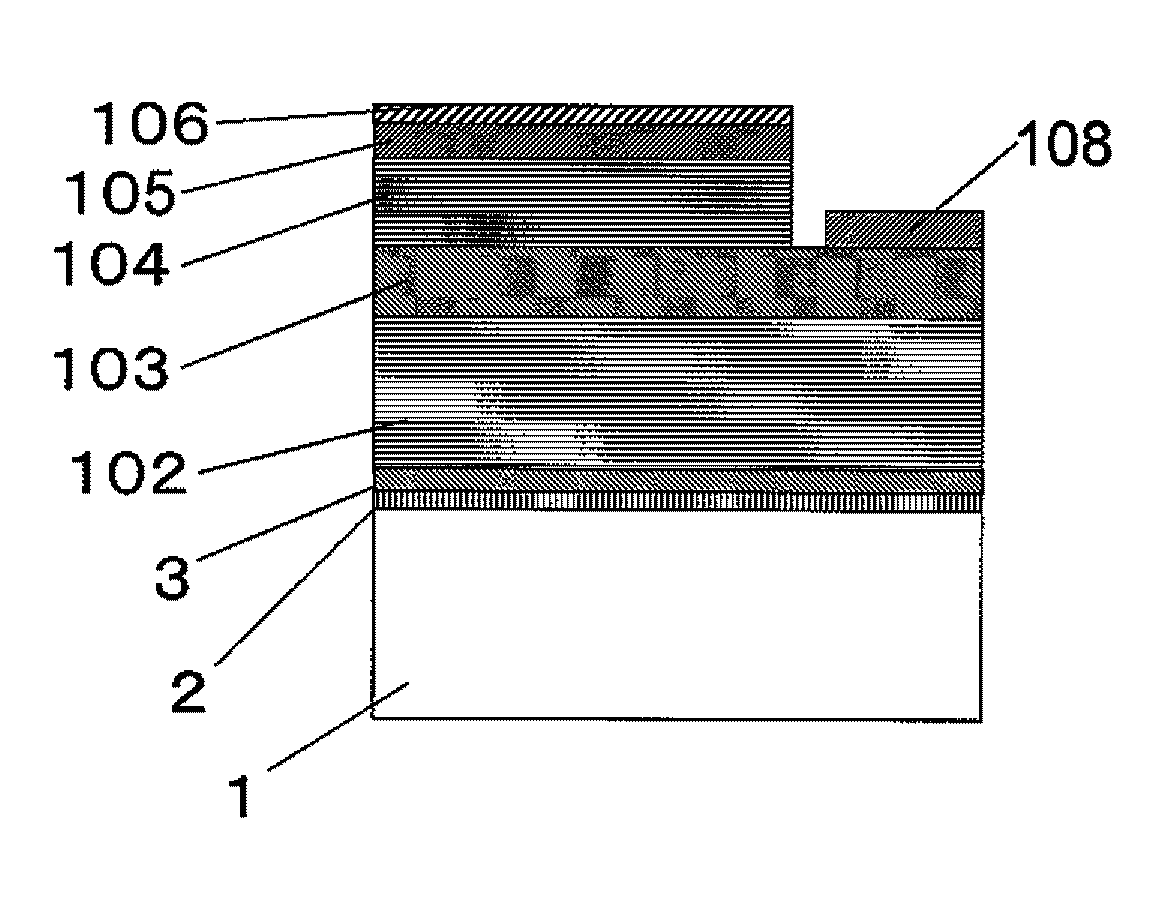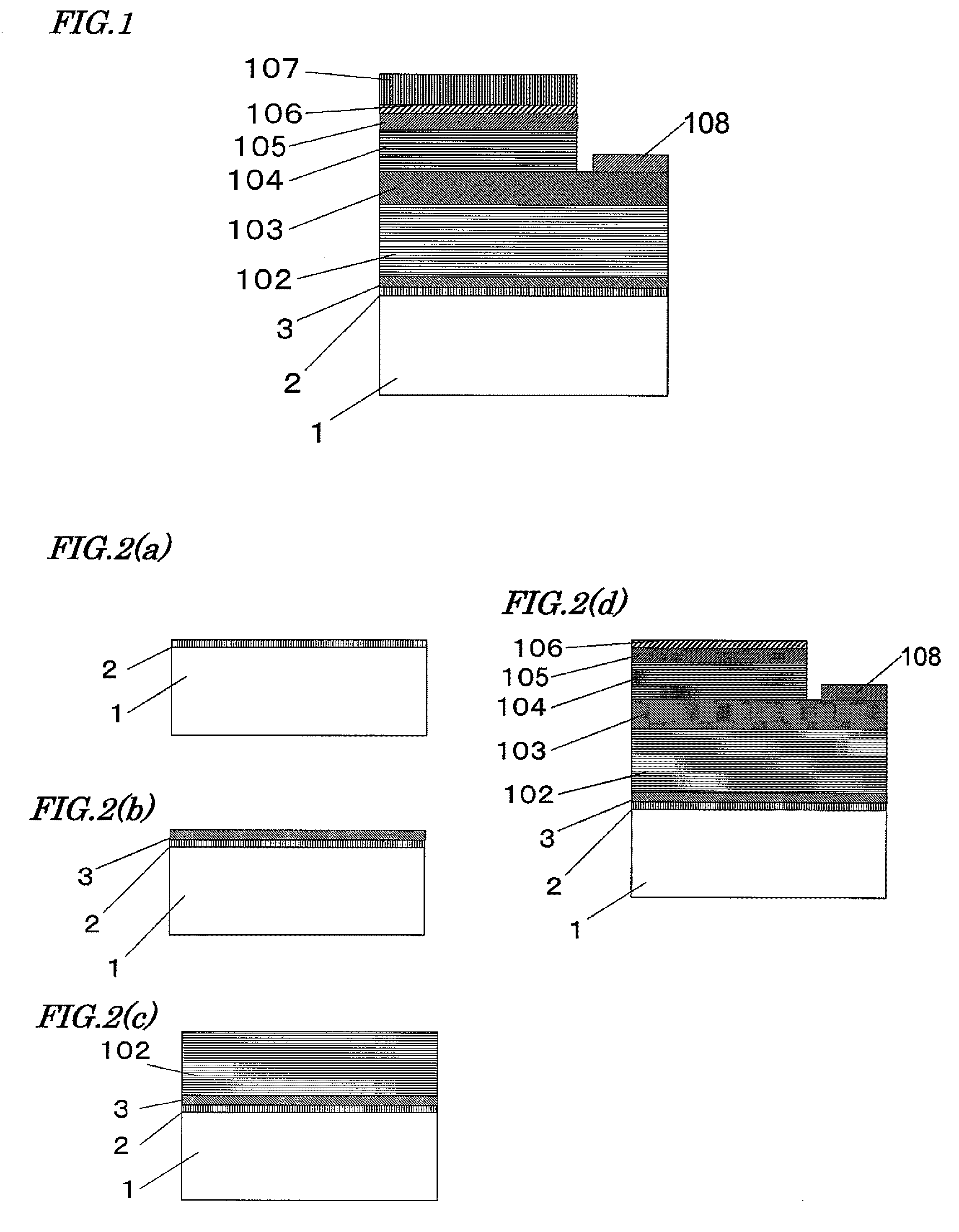Solar cell and method for fabricating the same
- Summary
- Abstract
- Description
- Claims
- Application Information
AI Technical Summary
Benefits of technology
Problems solved by technology
Method used
Image
Examples
embodiment 1
[0055]FIG. 1 shows a cross-sectional view of the solar cell according to the embodiment 1 of the present invention.
[0056]In FIG. 1, referential mark 1 indicates a graphite substrate. Referential mark 2 indicates an amorphous carbon layer which is caused to be amorphous by an oxygen-ashing treatment on the surface of the graphite substrate 1. The oxygen-ashing treatment includes a treatment by oxygen plasma. Referential mark 3 indicates an AlN layer formed on the amorphous carbon layer 2 with MOCVD.
[0057]A p-side electrode 107 which is a transparent electrode made of, for example, ITO (indium tin oxide) or a bilayer of nickel (Ni) and gold (Au) is formed on a p-type contact layer 106. An n-side electrode 108 made of a laminate film of titanium (Ti) and aluminum (Al) is formed on the upper surface of an n-type GaN layer 103.
[0058]A fabrication method of the solar cell is described below with reference to the drawings.
[0059]FIG. 2(a) to FIG. 2(d) show cross-sectional views in the proce...
example 1
[0063]FIG. 3(a) shows the surface SEM observation image after AlN was deposited with MOCVD on the graphite substrate 1 where the surface treatment by the oxygen-ashing was not performed. FIG. 3(b) shows the surface SEM observation image after the AlN layer 3 with a thickness of 20 nanometers was formed with MOCVD on the graphite substrate provided with the amorphous carbon layer 2 with a thickness of 20 nanometers formed by the surface treatment of oxygen-ashing.
[0064]As is clear from FIG. 3(a), a dense AlN thin film was not formed on the graphite substrate 1 where the surface treatment of oxygen-ashing was not performed. Only a microcrystal such as a dendrite crystal was deposited. On the contrary, as is clear from FIG. 3(b), the dense AlN film was formed on the graphite substrate 1 provided with the amorphous carbon layer 2 on its surface.
[0065]FIG. 4(a) shows the cross-sectional TEM observation image of the substrate when the AlN layer 3 with a thickness of 20 nanometers formed w...
embodiment 2
[0082]FIG. 8 shows a cross-sectional view of the solar cell according to the embodiment 2 of the present invention. The difference from FIG. 1 lies in that the p-side electrode 109 is a zinc oxide (ZnO) film prepared by liquid phase synthesis.
PUM
| Property | Measurement | Unit |
|---|---|---|
| Nanoscale particle size | aaaaa | aaaaa |
| Nanoscale particle size | aaaaa | aaaaa |
| Energy | aaaaa | aaaaa |
Abstract
Description
Claims
Application Information
 Login to View More
Login to View More - R&D
- Intellectual Property
- Life Sciences
- Materials
- Tech Scout
- Unparalleled Data Quality
- Higher Quality Content
- 60% Fewer Hallucinations
Browse by: Latest US Patents, China's latest patents, Technical Efficacy Thesaurus, Application Domain, Technology Topic, Popular Technical Reports.
© 2025 PatSnap. All rights reserved.Legal|Privacy policy|Modern Slavery Act Transparency Statement|Sitemap|About US| Contact US: help@patsnap.com



